Satellite-Based Multi-Decadal Shoreline Change Detection by Integrating Deep Learning with DSAS: Eastern and Southern Coastal Regions of Peninsular Malaysia
Highlights
- Deep learning (U-Net, DeepLabV3+) integrated with DSAS enables accurate, large-scale shoreline change quantification, with U-Net outperforming in precision and generalizability.
- There is severe erosion in Kelantan (−64.9 m/yr), localized erosion in Pahang (>−50 m/yr), moderated change in Terengganu, and major accretion in Johor (>+1900 m).
- It provides a scalable framework for long-term coastal monitoring and climate adaptation.
- It supports evidence-based coastal management and policy by pinpointing erosion hotspots and evaluating human interventions.
Abstract
1. Introduction
2. Study Area
3. Materials and Methods
3.1. Data Acquisition
3.2. Deep Learning Models for Shoreline Extraction
3.2.1. U-Net Model
3.2.2. DeepLabV3+ Model
3.2.3. Training and Inference Procedure
3.3. Selection of DL Method for Shoreline Extraction
Non-DL Baselines and Benchmark Protocol
3.4. Shoreline Change Analysis
3.4.1. Shoreline Preparation
3.4.2. Uncertainty in Shoreline
3.4.3. Shoreline Change Metrics
4. Results and Analysis
4.1. Deep Learning Model Performance
4.2. Visual Comparison
4.3. Shoreline Change Analysis (DSAS)
Overall Shoreline Dynamics (1990–2024)
4.4. Spatial Distribution of Shoreline Dynamics
4.4.1. Kelantan Coast
4.4.2. Terengganu Coast
4.4.3. Pahang Coast
4.4.4. Johor (East and West Coast)
5. Discussion
5.1. Interpretation of Model Performance and Segmentation Accuracy
5.2. Evaluation of Long-Term Shoreline Change Trends
5.3. Implications for Coastal Monitoring and Management
5.4. Limitations and Future Work
- Utilizing higher-resolution satellite imagery (e.g., SPOT, PlanetScope);
- Conducting seasonal shoreline analysis to capture short-term variability;
- Applying ensemble deep learning models;
- Integrating DSAS outputs with hydrodynamic simulations to assess climate change–induced risks (e.g., storm surge, sea-level rise);
- Extending this framework to evaluate how shoreline change dynamics and model performance vary across contrasting coastal morphologies (e.g., mangrove-fringed coasts, sandy beaches, estuarine environments), as these settings may exhibit distinct responses to hydrodynamic forcing and anthropogenic interventions.
- Exploring automated shoreline updating systems using cloud computing platforms such as Google Earth Engine;
- Such advancements will improve both temporal resolution and model reliability, enhancing their value in operational coastal risk management.
6. Conclusions
Author Contributions
Funding
Data Availability Statement
Acknowledgments
Conflicts of Interest
Appendix A
| Metric | U-Net | NDWI-Otsu | Canny-Otsu |
|---|---|---|---|
| Accuracy | 0.987 | 0.952 | 0.972 |
| Precision—Land | 0.993 | 0.997 | 0.997 |
| Precision—Water | 0.984 | 0.963 | 0.963 |
| Recall—Land | 0.987 | 0.960 | 0.960 |
| Recall—Water | 0.988 | 0.957 | 0.957 |
| F1 Score—Land | 0.990 | 0.984 | 0.984 |
| F1 Score—Water | 0.986 | 0.980 | 0.980 |
| IoU—Land | 0.980 | 0.958 | 0.968 |
| IoU—Water | 0.973 | 0.960 | 0.960 |
| Dice—Land | 0.990 | 0.984 | 0.984 |
| Dice—Water | 0.986 | 0.980 | 0.980 |

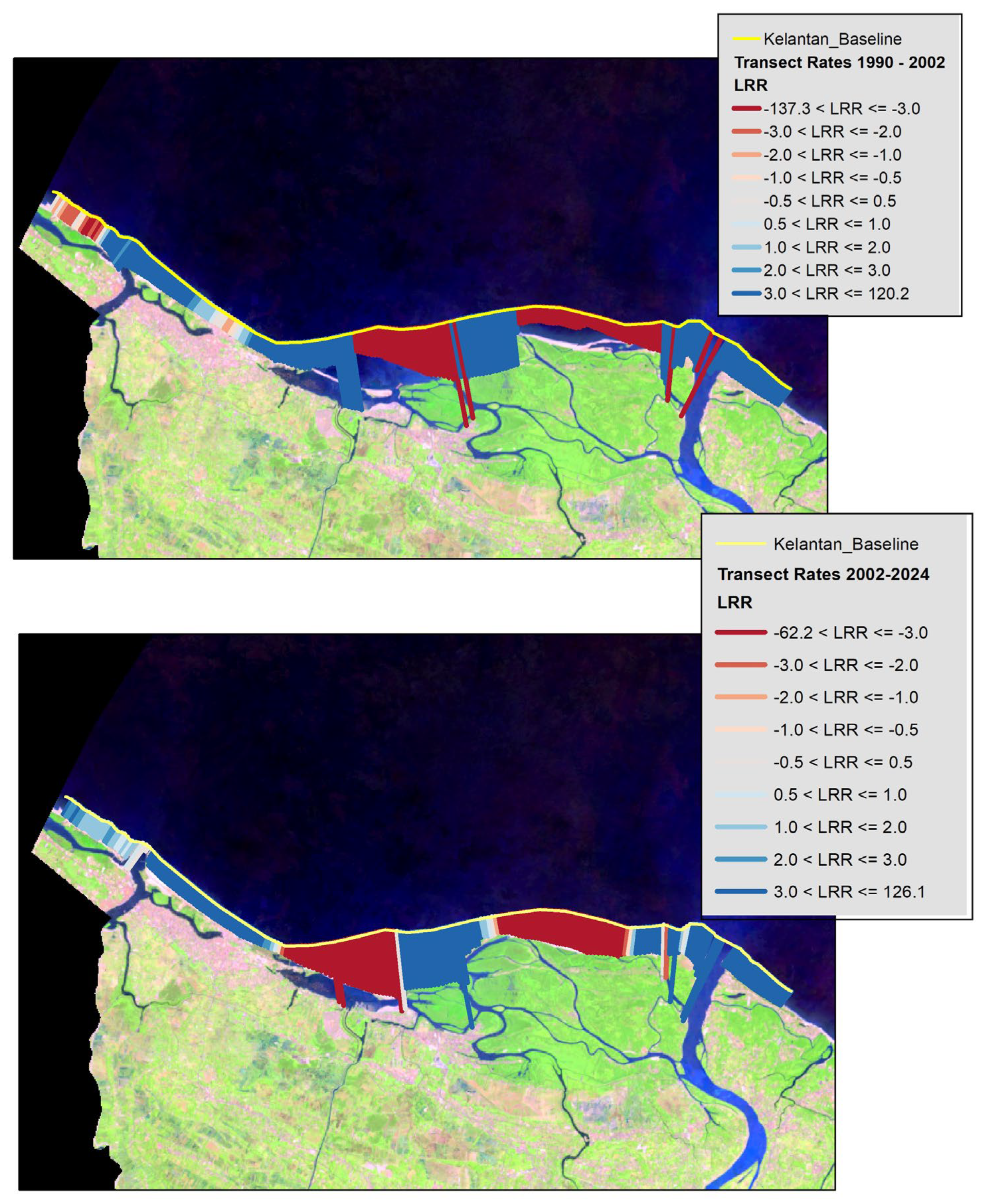
References
- Neumann, B.; Ott, K.; Kenchington, R. Strong Sustainability in Coastal Areas: A Conceptual Interpretation of SDG 14. Sustain. Sci. 2017, 12, 1019–1035. [Google Scholar] [CrossRef] [PubMed]
- Islam, G.M.N.; Khir, M.F.A.; Patwary, A.K. Environmental Pollution and Value of Ecotourism Resources in the “No-Take” Marine Protected Areas: A Case of Perhentian Marine Park, Malaysia. Sci. Talks 2024, 12, 100399. [Google Scholar] [CrossRef]
- Pendleton, L.; Evans, K.; Visbeck, M. We Need a Global Movement to Transform Ocean Science for a Better World. Proc. Natl. Acad. Sci. USA 2020, 117, 9652–9655. [Google Scholar] [CrossRef]
- Dhiman, R.; Kalbar, P.; Inamdar, A.B. Assimilating Geospatial and Decision Science: Application to Planning and Management of Urban Coasts. In Advances in Urban Planning in Developing Nations; Routledge: London, UK, 2021; pp. 140–159. [Google Scholar] [CrossRef]
- Bamunawala, J.; Ranasinghe, R.; Dastgheib, A.; Nicholls, R.J.; Murray, A.B.; Barnard, P.L.; Sirisena, T.A.J.G.; Duong, T.M.; Hulscher, S.J.M.H.; van der Spek, A. Twenty-First-Century Projections of Shoreline Change along Inlet-Interrupted Coastlines. Sci. Rep. 2021, 11, 14038. [Google Scholar] [CrossRef]
- Alvarez-Cuesta, M.; Toimil, A.; Losada, I.J. Reprint of: Modelling Long-Term Shoreline Evolution in Highly Anthropized Coastal Areas. Part 2: Assessing the Response to Climate Change. Coast. Eng. 2021, 169, 103985. [Google Scholar] [CrossRef]
- Nicholls, R.J.; Cazenave, A. Sea-Level Rise and Its Impact on Coastal Zones. Science (1979) 2010, 328, 1517–1520. [Google Scholar] [CrossRef]
- Le Cozannet, G.; Bulteau, T.; Castelle, B.; Ranasinghe, R.; Wöppelmann, G.; Rohmer, J.; Bernon, N.; Idier, D.; Louisor, J.; Salas-y-Mélia, D. Quantifying Uncertainties of Sandy Shoreline Change Projections as Sea Level Rises. Sci. Rep. 2019, 9, 42. [Google Scholar] [CrossRef]
- Aziz, A.F.; Mardi, N.H.; Abdul Malek, M.; Teh, S.Y.; Wil, M.A.; Shuja, A.H.; Ahmed, A.N.; Kumar, P.; Sherif, M.; Elshafie, A. Development of Inundation Maps along East Coast of Peninsular Malaysia Due to Predicted Seaquake from Manila Trench. Appl. Water Sci. 2023, 13, 62. [Google Scholar] [CrossRef]
- Dal Barco, M.K.; Furlan, E.; Pham, H.V.; Torresan, S.; Zachopoulos, K.; Kokkos, N.; Sylaios, G.; Critto, A. Multi-Scenario Analysis in the Apulia Shoreline: A Multi-Tiers Analytical Framework for the Combined Evaluation and Management of Coastal Erosion and Water Quality Risks. Environ. Sci. Policy 2024, 153, 103665. [Google Scholar] [CrossRef]
- Laignel, B.; Vignudelli, S.; Almar, R.; Becker, M.; Bentamy, A.; Benveniste, J.; Birol, F.; Frappart, F.; Idier, D.; Salameh, E.; et al. Observation of the Coastal Areas, Estuaries and Deltas from Space. Surv. Geophys. 2023, 44, 1309–1356. [Google Scholar] [CrossRef]
- Wang, G.; Duan, Z.; Yu, T.; Shen, Z.; Zhang, Y. Analysis of Coastline Changes under the Impact of Human Activities during 1985–2020 in Tianjin, China. PLoS ONE 2023, 18, e0289969. [Google Scholar] [CrossRef]
- Dong, W.S.; Ismailluddin, A.; Yun, L.S.; Ariffin, E.H.; Saengsupavanich, C.; Abdul Maulud, K.N.; Ramli, M.Z.; Miskon, M.F.; Jeofry, M.H.; Mohamed, J.; et al. The Impact of Climate Change on Coastal Erosion in Southeast Asia and the Compelling Need to Establish Robust Adaptation Strategies. Heliyon 2024, 10, e25609. [Google Scholar] [CrossRef]
- Ariffin, E.H.; Mathew, M.J.; Roslee, A.; Ismailluddin, A.; Yun, L.S.; Putra, A.B.; Yusof, K.M.K.K.; Menhat, M.; Ismail, I.; Shamsul, H.A.; et al. A Multi-Hazards Coastal Vulnerability Index of the East Coast of Peninsular Malaysia. Int. J. Disaster Risk Reduct. 2023, 84, 103484. [Google Scholar] [CrossRef]
- Angelini, R.; Angelats, E.; Luzi, G.; Ribas, F.; Masiero, A.; Mugnai, F. A review and test of shoreline extraction techniques. Int. Arch. Photogramm. Remote Sens. Spat. Inf. Sci. 2023, 48, 17–24. [Google Scholar] [CrossRef]
- Rostami, E.; Sharifi, M.A.; Hasanlou, M. Shoreline extraction using time series of sentinel-2 satellite images by google earth engine platform. ISPRS Ann. Photogramm. Remote Sens. Spat. Inf. Sci. 2023, 10, 653–659. [Google Scholar] [CrossRef]
- Effendi Daud, M.; Ikhmal Siddiq bin Jefri Din, M.; Kaamin, M.; Mokhtar, M.; Ikhmal Siddiq Jefri Din, M.; Helmy Ariffin, E.; Anh Duong, N.; Onn Malaysia Kampus Cawangan Pagoh, H.; Pendidikan Tinggi Pagoh, H.; Panchor, J. Mapping the Shoreline: A Review of Satellite Imagery and Drone-Mapping Based Shoreline Digitization Methods. J. Adv. Res. Appl. Sci. Eng. Technol. J. Homepage 2025, 61, 193–207. [Google Scholar] [CrossRef]
- Ennouali, Z.; Fannassi, Y.; Benmohammadi, A.; Al-Mutiry, M.; Masria, A. Shoreline Change Detection along North Sebou–Moulay Bousselham, Based on Remote Sensing Analysis. Reg. Stud. Mar. Sci. 2023, 62, 102935. [Google Scholar] [CrossRef]
- Scala, P.; Manno, G.; Ciraolo, G. Semantic Segmentation of Coastal Aerial/Satellite Images Using Deep Learning Techniques: An Application to Coastline Detection. Comput. Geosci. 2024, 192, 105704. [Google Scholar] [CrossRef]
- Ramachandran, A.; Sujatha, M.; Alruwais, N.; Alshahrani, H.M. Forecasting Coastal Stability: Digital Shoreline Analysis System and Machine Learning Techniques in Evaluating Impacts of Cyclones. Reg. Stud. Mar. Sci. 2025, 81, 103961. [Google Scholar] [CrossRef]
- Blais, M.A.; Akhloufi, M.A. Advances in Remote Sensing and Deep Learning in Coastal Boundary Extraction for Erosion Monitoring. Geomatics 2025, 5, 9. [Google Scholar] [CrossRef]
- Yum, S.G.; Park, S.; Lee, J.J.; Adhikari, M. Das A Quantitative Analysis of Multi-Decadal Shoreline Changes along the East Coast of South Korea. Sci. Total Environ. 2023, 876, 162756. [Google Scholar] [CrossRef] [PubMed]
- Zhao, Q.; Yu, L.; Du, Z.; Peng, D.; Hao, P.; Zhang, Y.; Gong, P. An Overview of the Applications of Earth Observation Satellite Data: Impacts and Future Trends. Remote Sens. 2022, 14, 1863. [Google Scholar] [CrossRef]
- García-Rubio, G.; Huntley, D.; Russell, P. Evaluating Shoreline Identification Using Optical Satellite Images. Mar. Geol. 2015, 359, 96–105. [Google Scholar] [CrossRef]
- Ankrah, J.; Monteiro, A.; Madureira, H. Bibliometric Analysis of Data Sources and Tools for Shoreline Change Analysis and Detection. Sustainability 2022, 14, 4895. [Google Scholar] [CrossRef]
- Boak, E.H.; Turner, I.L. Shoreline Definition and Detection: A Review. J. Coast. Res. 2005, 2005, 688–703. [Google Scholar] [CrossRef]
- Lv, Q.; Wang, Q.; Song, X.; Ge, B.; Guan, H.; Lu, T.; Tao, Z. Research on Coastline Extraction and Dynamic Change from Remote Sensing Images Based on Deep Learning. Front. Environ. Sci. 2024, 12, 1443512. [Google Scholar] [CrossRef]
- Park, S.; Song, A. Shoreline Change Analysis with Deep Learning Semantic Segmentation Using Remote Sensing and GIS Data. KSCE J. Civ. Eng. 2024, 28, 928–938. [Google Scholar] [CrossRef]
- Qiu, K.; Budde, L.E.; Bulatov, D.; Iwaszczuk, D. Exploring Fusion Techniques in U-Net and DeepLab V3 Architectures for Multi-Modal Land Cover Classification. In Proceedings of the Earth Resources and Environmental Remote Sensing/GIS Applications XIII, Berlin, Germany, 5–8 September 2022; Schulz, K., Nikolakopoulos, K.G., Michel, U., Eds.; SPIE: Berlin, Germany, 2022; p. 33. [Google Scholar]
- Handayanto, R.T. Land Cover Segmentation of Multispectral Images Using U-Net and DeeplabV3+ Architecture. J. Ilmu Komput. Inf. 2024, 17, 89–96. [Google Scholar] [CrossRef]
- Mahmoud, A.S.; Mohamed, S.A.; Helmy, A.K.; Nasr, A.H. BDCN_UNet: Advanced Shoreline Extraction Techniques Integrating Deep Learning. Earth Sci. Inf. 2025, 18, 187. [Google Scholar] [CrossRef]
- Khurram, S.; Pour, A.B.; Bagheri, M.; Ariffin, E.H.; Akhir, M.F.; Hamzah, S.B. Developments in Deep Learning Algorithms for Coastline Extraction from Remote Sensing Imagery: A Systematic Review. Earth Sci. Inf. 2025, 18, 187. [Google Scholar] [CrossRef]
- Wu, L.; Ishikawa, S.; Inazu, D.; Ikeya, T.; Okayasu, A. An Automatic Shoreline Extraction Method from SAR Imagery Using DeepLab-V3+ and Its Versatility. Coast. Eng. J. 2025, 67, 106–118. [Google Scholar] [CrossRef]
- Amara, R.; Diop, M.; Diop, C.; Ouddane, B. The Senegalese Coastal and Marine Environment. In World Seas: An Environmental Evaluation; Elsevier: Amsterdam, The Netherlands, 2019; pp. 855–873. [Google Scholar]
- Bagheri, M.; Akhir, M.F.; Gholami, I.; Wolf, I.D.; Nor, N.N.F.B.M.; Yusoff, I.M.; Rashid, S.M.R.A. Assessing Coastal Erosion Dynamics and Sea Level Rise Impacts on Kuala Nerus and Kuala Terengganu, Malaysia: A Case Study in Climate-Resilient Coastal Management. Epis. J. Int. Geosci. 2024, 48, 255–278. [Google Scholar] [CrossRef]
- Rashidi, A.H.M.; Jamal, M.H.; Hassan, M.Z.; Sendek, S.S.M.; Sopie, S.L.M.; Hamid, M.R.A. Coastal Structures as Beach Erosion Control and Sea Level Rise Adaptation in Malaysia: A Review. Water 2021, 13, 1741. [Google Scholar] [CrossRef]
- Ariffin, E. Effect of Monsoons on Beach Morphodynamics in the East Coast of Peninsular Malaysia: Examples from Kuala Terengganu Coast. Ph.D. Thesis, Université de Bretagne Sud, Lorient, France, 2017. [Google Scholar]
- Rojahan, A.; Ibrahim, I.; Noor, N. Analysis of Rate of Shoreline Changes along the Coastline of Kuala Terengganu. Malays. J. Trop. Geogr. 2022, 48, 64–72. [Google Scholar]
- Zuraimi, A.; Rafi, Y.; Dahlan, I.; Fadiah, M. A study of logistics development in the malaysia eastern region: A descriptive analysis. Int. J. Bus. Soc. Res. 2012, 2, 309–321. [Google Scholar]
- Ahmad, H.; Abdul Maulud, K.N.; Karim, O.A.; Mohd, F.A. Assessment of Erosion and Hazard in the Coastal Areas of Selangor. Malays. J. Soc. Space 2021, 17, 14–31. [Google Scholar] [CrossRef]
- Azizan, N.N.; Abdul Rahim, H.; Adnan, N.A.; Razali, R.; Mohd, F.A.; Ariffin, E.H. Assessment of Shoreline Changes at Northern Selangor Coast, Malaysia Using Digital Shoreline Analysis System (DSAS). J. Adv. Geospat. Sci. Technol. 2024, 4, 79–103. [Google Scholar] [CrossRef]
- Ehsan, S.; Begum, R.A.; Nor, N.G.M.; Maulud, K.N.A. Current and Potential Impacts of Sea Level Rise in the Coastal Areas of Malaysia. IOP Conf. Ser. Earth Environ. Sci. 2019, 228, 012023. [Google Scholar] [CrossRef]
- Wulder, M.A.; Loveland, T.R.; Roy, D.P.; Crawford, C.J.; Masek, J.G.; Woodcock, C.E.; Allen, R.G.; Anderson, M.C.; Belward, A.S.; Cohen, W.B.; et al. Current Status of Landsat Program, Science, and Applications. Remote Sens. Environ. 2019, 225, 127–147. [Google Scholar] [CrossRef]
- Mishra, M.; Acharyya, T.; Chand, P.; Santos, C.A.G.; Kar, D.; Das, P.P.; Pattnaik, N.; da Silva, R.M.; do Nascimento, T.V.M. Analyzing Shoreline Dynamicity and the Associated Socioecological Risk along the Southern Odisha Coast of India Using Remote Sensing-Based and Statistical Approaches. Geocarto Int. 2022, 37, 3991–4027. [Google Scholar] [CrossRef]
- Dolan, R.; Fenster, M.; Holme, S. Temporal Analysis of Shoreline Recession and Accretion. J. Coast. Res. 1991, 7, 723–744. [Google Scholar]
- Moore, L. Shoreline Mapping Techniques. J. Coast. Res. (JSTOR) 2000, 16, 111–124. [Google Scholar]
- Liu, Y.; Yang, J.; He, J.; Chen, X.; Yuan, H.; Peng, X. Roof Segmentation of Remote Sensing Images Based on Improved UNET. In Proceedings of the International Conference on Wavelet Analysis and Pattern Recognition, Adelaide, Australia, 9–11 July 2023; pp. 68–73. [Google Scholar] [CrossRef]
- Wang, X.; Hu, Z.; Shi, S.; Hou, M.; Xu, L.; Zhang, X. A Deep Learning Method for Optimizing Semantic Segmentation Accuracy of Remote Sensing Images Based on Improved UNet. Sci. Rep. 2023, 13, 7600. [Google Scholar] [CrossRef] [PubMed]
- He, K.; Zhang, X.; Ren, S.; Sun, J. Deep Residual Learning for Image Recognition. In Proceedings of the 2016 IEEE Conference on Computer Vision and Pattern Recognition (CVPR), Las Vegas, NV, USA, 27–30 June 2016; IEEE: New York, NY, USA, 2016; pp. 770–778. [Google Scholar]
- Gong, S.; Ball, J.; Surawski, N. Urban Land-Use Land-Cover Extraction for Catchment Modelling Using Deep Learning Techniques. J. Hydroinform. 2022, 24, 388–405. [Google Scholar] [CrossRef]
- Chen, L.-C.; Zhu, Y.; Papandreou, G.; Schroff, F.; Adam, H. Encoder-Decoder with Atrous Separable Convolution for Semantic Image Segmentation. In Proceedings of the European Conference on Computer Vision, Munich, Germany, 8–14 September 2018; SpringerLink: Berlin, Germany, 2018; pp. 801–818. [Google Scholar]
- Chen, H.; Qin, Y.; Liu, X.; Wang, H.; Zhao, J. An Improved DeepLabv3+ Lightweight Network for Remote-Sensing Image Semantic Segmentation. Complex Intell. Syst. 2024, 10, 2839–2849. [Google Scholar] [CrossRef]
- Jun, Z.; Shiqiao, C.; Zhenhua, D.; Yuan, Z.; Chabei, L. Automatic Detection for Dam Restored Concrete Based on DeepLabv3+. IOP Conf. Ser. Earth Environ. Sci. 2020, 571, 012108. [Google Scholar] [CrossRef]
- Matin, N.; Hasan, G.M.J. A Quantitative Analysis of Shoreline Changes along the Coast of Bangladesh Using Remote Sensing and GIS Techniques. Catena 2021, 201, 105185. [Google Scholar] [CrossRef]
- Kong, D.; Miao, C.; Borthwick, A.G.L.; Duan, Q.; Liu, H.; Sun, Q.; Ye, A.; Di, Z.; Gong, W. Evolution of the Yellow River Delta and Its Relationship with Runoff and Sediment Load from 1983 to 2011. J. Hydrol. 2015, 520, 157–167. [Google Scholar] [CrossRef]
- Kandel, I.; Castelli, M. The Effect of Batch Size on the Generalizability of the Convolutional Neural Networks on a Histopathology Dataset. ICT Express 2020, 6, 312–315. [Google Scholar] [CrossRef]
- Fernando, K.R.M.; Tsokos, C.P. Dynamically Weighted Balanced Loss: Class Imbalanced Learning and Confidence Calibration of Deep Neural Networks. IEEE Trans. Neural Netw. Learn. Syst. 2022, 33, 2940–2951. [Google Scholar] [CrossRef]
- Tyagi, S.; Mittal, S. Sampling Approaches for Imbalanced Data Classification Problem in Machine Learning. Lect. Notes Electr. Eng. 2020, 597, 209–221. [Google Scholar] [CrossRef]
- Himmelstoss, E.A.; Henderson, R.E.; Kratzmann, M.G.; Farris, A.S. Digital Shoreline Analysis System (DSAS) Version 5.0 User Guide; Open-File Report; USGS: Reston, VA, USA, 2018.
- Azad, S.T.; Moghaddassi, N.; Sayehbani, M. Digital Shoreline Analysis System Improvement for Uncertain Data Detection in Measurements. Environ. Monit. Assess. 2022, 194, 646. [Google Scholar] [CrossRef]
- Quang, D.N.; Ngan, V.H.; Tam, H.S.; Viet, N.T.; Tinh, N.X.; Tanaka, H. Long-Term Shoreline Evolution Using DSAS Technique: A Case Study of Quang Nam Province, Vietnam. J. Mar. Sci. Eng. 2021, 9, 1124. [Google Scholar] [CrossRef]
- Abd Wahid, M.Z.A.; Osman, M.S.; Setumin, S. Comparative Analysis in Shoreline Changes in Kelantan, Malaysia Using Digital Shoreline Analysis System (DSAS). ESTEEM Acad. J. 2023, 19, 109–117. [Google Scholar] [CrossRef]
- Rafferty, S.; Naber, M. An Analysis of Bluff Change along the Pennsylvania Lake Erie Coast: 2007-15 and 2012-15. 2021. Pennsylvania Sea Grant, Pennsylvania State University. Available online: https://pawalter.psu.edu/sites/default/files/resources/Bluff%20Analysis%20Report%20%282021%29.pdf (accessed on 2 September 2025).
- Murray, J.; Adam, E.; Woodborne, S.; Miller, D.; Xulu, S.; Evans, M. Monitoring Shoreline Changes along the Southwestern Coast of South Africa from 1937 to 2020 Using Varied Remote Sensing Data and Approaches. Remote Sens. 2023, 15, 317. [Google Scholar] [CrossRef]
- Harikrishna, S.; Gurugnanam, B.; Bairavi, S.; Shekar, S. Geospatial Technology Based Shoreline Change Analysis (1992–2022) and Predictive Forecast Modeling for 2032 and 2042, Utilizing DSAS, along the Eastern Coast of India. Kuwait J. Sci. 2024, 51, 100272. [Google Scholar] [CrossRef]
- Hamsan, M.A.S.; Zaini Mustapa, M.; Ramli, M.Z. Morphology and sand characteristics at five recreational beaches in Pahang. J. Sustain. Sci. Manag. 2019, 14, 2672–7226. [Google Scholar]
- Hayes, M. Barrier Island Morphology as a Function of Tidal and Wave Regime; Leatherman, S.P., Ed.; Academic Press: Columbia, SC, USA, 1979; pp. 1–29. [Google Scholar]
- Uti, M.N.; Din, A.H.M.; Yusof, N.; Rasib, A.W.; Hamden, M.H.; Hashim, F.E. Assessment of the Potential of Tidal Range Energy in Malaysian Exclusive Economic Zone (EEZ) Using Multi-Mission Satellite Altimetry Data. Int. J. Geoinformatics 2023, 19, 1–14. [Google Scholar] [CrossRef]
- Wong, P.P. Beach Changes on a Monsoon Coast, Peninsular Malaysia. Bull. Geol. Soc. Malays. 1981, 14, 59–74. [Google Scholar] [CrossRef]
- Rengarajan, R.; Choate, M.; Hasan, M.N.; Denevan, A. Co-Registration Accuracy between Landsat-8 and Sentinel-2 Orthorectified Products. Remote Sens. Environ. 2024, 301, 113947. [Google Scholar] [CrossRef]
- Storey, J.; Choate, M.; Lee, K.; Markham, B.; Morfitt, R.; Müller, R.; Thenkabail, P.S. Landsat 8 Operational Land Imager On-Orbit Geometric Calibration and Performance. Remote Sens. 2014, 6, 11127–11152. [Google Scholar] [CrossRef]
- Rengarajan, R.; Choate, M.; Storey, J.; Franks, S.; Micijevic, E. Landsat Collection-2 Geometric Calibration Updates. In Proceedings of the Earth Observing Systems XXV, Online, 24 August–4 September 2020. [Google Scholar] [CrossRef]
- Choate, M.J.; Rengarajan, R.; Storey, J.C.; Lubke, M. Geometric Calibration Updates to Landsat 7 ETM+ Instrument for Landsat Collection 2 Products. Remote Sens. 2021, 13, 1638. [Google Scholar] [CrossRef]
- USGS. Landsat Levels of Processing|U.S. Geological Survey. Available online: https://www.usgs.gov/landsat-missions/landsat-levels-processing (accessed on 2 September 2025).
- Ahmed, M.F.; Halder, B.; Juneng, L.; Farooque, A.A.; Yaseen, Z.M. Remote Sensing-Based Shoreline Change Investigation in Klang Coast and Langkawi Island towards Sustainable Coastal Management. Geomat. Nat. Hazards Risk 2025, 16, 2493226. [Google Scholar] [CrossRef]
- Ridzuan, N. Evaluating Coastal Erosion and Accretion Along Batu Ferringhi Beach with Digital Shoreline Analysis System. BIO Web Conf. 2025, 176, 01001. [Google Scholar] [CrossRef]
- Goodfellow, I.; Bengio, Y.; Courville, A. Deep Learning; The MIT Press: Cambridge, MA, USA; London, UK, 2016; ISBN 9780262035613. [Google Scholar]
- Chollet, F. Deep Learning with Python, 2nd ed.; Manning Publications: Shelter Island, NY, USA, 2021; ISBN 9781617296864. [Google Scholar]
- Bengio, Y. Practical Recommendations for Gradient-Based Training of Deep Architectures, 2nd ed.; Springer: Berlin/Heidelberg, Germany, 2012; Volume 7700, ISBN 978-3-642-35289-8. [Google Scholar]
- Zulfakar, M.; Akhir, M.; Ariffin, E.; Awang, N.; Yaacob, M.; Chong, W.; Muslim, A. The Effect of Coastal Protections on the Shoreline Evolution at Kuala Nerus, Terengganu (Malaysia). J. Sustain. Sci. Manag. 2020, 15, 71–85. [Google Scholar]
- Chueprasert, T.; Udomchaiporn, A.; Intagosum, S. Comparative Analysis of Deep Learning Models for Building Extraction from High-Resolution Satellite Imagery. Curr. Appl. Sci. Technol. 2024, 25, e0260846. [Google Scholar] [CrossRef]
- Kalinaki, K.; Malik, O.A.; Ching Lai, D.T. FCD-AttResU-Net: An Improved Forest Change Detection in Sentinel-2 Satellite Images Using Attention Residual U-Net. Int. J. Appl. Earth Obs. Geoinf. 2023, 122, 103453. [Google Scholar] [CrossRef]
- Chang, L.; Chen, Y.T. Performance Evaluation and Improvement of Shoreline Detection Using Sentinel-1 SAR and DEM Data. IEEE J. Sel. Top. Appl. Earth Obs. Remote Sens. 2024, 17, 8139–8152. [Google Scholar] [CrossRef]
- Lin, H.; Li, L.; Qiang, Y.; Xu, X.; Liang, S.; Chen, T.; Yang, W.; Zhang, Y. A Method for Landslide Identification and Detection in High-Precision Aerial Imagery: Progressive CBAM-U-Net Model. Earth Sci. Inf. 2024, 17, 5487–5498. [Google Scholar] [CrossRef]
- Said ATAŞ, M.; Doğan, Y.; Özdemiïr, C.; Bilgileri, M. Performance Comparison of Deep Learning Lane Detection Models for Autonomous Vehicles. Çukurova Üniversitesi Mühendislik Fakültesi Derg. 2024, 39, 861–871. [Google Scholar] [CrossRef]
- Boye, C.B.; Appeaning Addo, K.; Williams Boye, E.A.; Addo, A. Positional Accuracy Assessment for Effective Shoreline Change Analyses. Ghana Min. J. 2016, 16, 1–7. [Google Scholar] [CrossRef][Green Version]
- Fejjari, A.; Valentino, G.; Briffa, J.A.; D’Amico, S. Detection and Monitoring of Maltese Shoreline Changes Using Sentinel-2 Imagery. In Proceedings of the IEEE International Workshop on Metrology for the Sea; Learning to Measure Sea Health Parameters (MetroSea), Genoa, Italy, 4–6 October 2023; pp. 52–56. [Google Scholar] [CrossRef]
- Zhang, Z.; Bao, L.; Xiang, S.; Xie, G.; Gao, R. B2CNet: A Progressive Change Boundary-to-Center Refinement Network for Multitemporal Remote Sensing Images Change Detection. IEEE J. Sel. Top. Appl. Earth Obs. Remote Sens. 2024, 17, 11322–11338. [Google Scholar] [CrossRef]
- Tang, W.; He, L. A Network for Detecting Changes in Remote Sensing Images Relies on Boundary Detection and Differential Enhancement. In Proceedings of the 2024 5th International Conference on Computer Engineering and Application (ICCEA), Hangzhou, China, 12–14 April 2024; IEEE: New York, NY, USA, 2024; pp. 1062–1066. [Google Scholar]
- Selamat, S.N.; Abdul Maulud, K.N.; Mohd, F.A.; Ab Rahman, A.A.; Zainal, M.K.; Abdul Wahid, M.A.; Hamzah, M.L.; Ariffin, E.H.; Awang, N.A. Multi method analysis for identifying the shoreline erosion during northeast monsoon season. J. Sustain. Sci. Manag. 2019, 14, 43–54. [Google Scholar]
- Abdul Rahim, H.; Isa, F.I.; Adnan, N.A.; Mohd, F.A. Coastal Vulnerability Index and Impact of Erosion Along Terengganu Coastline. J. Adv. Geospat. Sci. Technol. 2023, 3, 1–24. [Google Scholar] [CrossRef]
- Chan, N.W. Impacts of Disasters and Disaster Risk Management in Malaysia: The Case of Floods. In Economics and Welfare Impacts of Disasters in East Asia and Policy Responses; Sawada, Y., Oum, S., Eds.; Springer: Berlin/Heidelberg, Germany, 2014; pp. 503–551. [Google Scholar]
- Yahaya, N.; Lim, C.; Jamaluddin, U.; Pereira, J. The December 2014 Flood in Kelantan: A Post-Event Perspective. Warta Geologi 2016, 41, 54. [Google Scholar]
- Abdul Hadi, A.R.; Ghani, M.R.A.; Talib, J.; Nur Afiqah, I. Geomorphology and Hydrology of 2014 Kelantan Flood. In Proceedings of the ICIPEG 2016 International Conference on Integrated Petroleum Engineering and Geosciences, Kuala Lumpur, Malaysia, 15–17 August 2016; pp. 655–668. [Google Scholar] [CrossRef]
- Abdullah, S.M. Kelantan Villagers Breathe Easy after Beach Communities Saved from Erosion Threat. Available online: https://www.nst.com.my/news/nation/2019/11/539829/kelantan-villagers-breathe-easy-after-beach-communities-saved-erosion (accessed on 3 September 2025).
- Ariffin, E.H.; Sedrati, M.; Akhir, M.F.; Daud, N.R.; Yaacob, R.; Husain, M.L. Beach Morphodynamics and Evolution of Monsoon-Dominated Coasts in Kuala Terengganu, Malaysia: Perspectives for Integrated Management. Ocean Coast. Manag. 2018, 163, 498–514. [Google Scholar] [CrossRef]
- Bagheri, M.; Zaiton Ibrahim, Z.; Bin Mansor, S.; Abd Manaf, L.; Badarulzaman, N.; Vaghefi, N. Shoreline Change Analysis and Erosion Prediction Using Historical Data of Kuala Terengganu, Malaysia. Environ. Earth Sci. 2019, 78, 477. [Google Scholar] [CrossRef]
- Narashid, R.H.; Zakaria, M.A.; Mohd, F.A.; Pa’sUya, M.F.; Talib, N.; Ariffin, E.H. Effect of Erosion and Accretion on Beach Profile in Kuala Terengganu Coastal Areas. IOP Conf. Ser. Earth Environ. Sci. 2021, 620, 012008. [Google Scholar] [CrossRef]
- Dong, W.S.; Ariffin, E.H.; Saengsupavanich, C.; Mohd Rashid, M.A.; Mohd Shukri, M.H.; Ramli, M.Z.; Miskon, M.F.; Jeofry, M.H.; Yunus, K.; Ghazali, N.H.M.; et al. Adaptation of Coastal Defence Structure as a Mechanism to Alleviate Coastal Erosion in Monsoon Dominated Coast of Peninsular Malaysia. J. Environ. Manag. 2023, 333, 117391. [Google Scholar] [CrossRef]
- Mohd, F.A.; Abdul Maulud, K.N.; Begum, R.A.; Selamat, S.N.; Karim, O.A. Impact of Shoreline Changes to Pahang Coastal Area by Using Geospatial Technology. Sains Malays. 2018, 47, 991–997. [Google Scholar] [CrossRef]
- Mohd, F.A.; Abdul Maulud, K.N.; Karim, O.A.; Begum, R.A.; Awang, N.A.; Ahmad, A.; Wan Mohamed Azhary, W.A.H.; Kamarudin, M.K.A.; Jaafar, M.; Wan Mohtar, W.H.M. Comprehensive Coastal Vulnerability Assessment and Adaptation for Cherating-Pekan Coast, Pahang, Malaysia. Ocean Coast. Manag. 2019, 182, 104948. [Google Scholar] [CrossRef]
- Wang, X.G.; Su, F.Z.; Zhang, J.J.; Cheng, F.; Hu, W.Q.; Ding, Z. Construction Land Sprawl and Reclamation in the Johor River Estuary of Malaysia since 1973. Ocean Coast. Manag. 2019, 171, 87–95. [Google Scholar] [CrossRef]
- Zulkifle, N.A.N.; Idris, N.H.; Ahmad, S.S.F. The Assessment of Shoreline Changes along the Johor Strait Using Sentinel-1 Synthetic Aperture Radar Imagery and GIS. Int. J. Remote Sens. 2024, 45, 8703–8721. [Google Scholar] [CrossRef]
- Awang, N.A.; Jusoh, W.H.W.; Hamid, M.R.A. Coastal Erosion at Tanjong Piai, Johor, Malaysia. J. Coast. Res. 2014, 71, 122–130. [Google Scholar] [CrossRef]
- Manaf, S.A.; Mustapha, N.; Sulaiman, M.N.; Husin, N.A.; Abdul Hamid, M.R. Change Analysis on Historical Shorelines Extracted from Medium Resolution Satellite Images: A Case Study on the Southern Coast of Peninsular Malaysia. IOP Conf. Ser. Earth Environ. Sci. 2018, 169, 012101. [Google Scholar] [CrossRef]
- Wang, Y.; Liu, Y.; Jin, S.; Sun, C.; Wei, X. Evolution of the Topography of Tidal Flats and Sandbanks along the Jiangsu Coast from 1973 to 2016 Observed from Satellites. ISPRS J. Photogramm. Remote Sens. 2019, 150, 27–43. [Google Scholar] [CrossRef]
- Luijendijk, A.; Hagenaars, G.; Ranasinghe, R.; Baart, F.; Donchyts, G.; Aarninkhof, S. The State of the World’s Beaches. Sci. Rep. 2018, 8, 6641. [Google Scholar] [CrossRef] [PubMed]
- Vos, K.; Harley, M.D.; Splinter, K.D.; Simmons, J.A.; Turner, I.L. Sub-Annual to Multi-Decadal Shoreline Variability from Publicly Available Satellite Imagery. Coast. Eng. 2019, 150, 160–174. [Google Scholar] [CrossRef]
- Ervita, K.; Marfai, M.A.; Ervita, K.; Marfai, M.A. Shoreline Change Analysis in Demak, Indonesia. J Environ. Prot. 2017, 8, 940–955. [Google Scholar] [CrossRef]
- Muskananfola, M.R.; Supriharyono; Febrianto, S. Spatio-Temporal Analysis of Shoreline Change along the Coast of Sayung Demak, Indonesia Using Digital Shoreline Analysis System. Reg. Stud. Mar. Sci. 2020, 34, 101060. [Google Scholar] [CrossRef]
- Bishop-Taylor, R.; Nanson, R.; Sagar, S.; Lymburner, L. Mapping Australia’s Dynamic Coastline at Mean Sea Level Using Three Decades of Landsat Imagery. Remote Sens. Environ. 2021, 267, 112734. [Google Scholar] [CrossRef]
- Hastuti, A.W.; Nagai, M.; Suniada, K.I. Coastal Vulnerability Assessment of Bali Province, Indonesia Using Remote Sensing and GIS Approaches. Remote Sens. 2022, 14, 4409. [Google Scholar] [CrossRef]
- Hastuti, A.W.; Nagai, M.; Ismail, N.P.; Priyono, B.; Suniada, K.I.; Wijaya, A. Spatiotemporal Analysis of Shoreline Change Trends and Adaptation in Bali Province, Indonesia. Reg. Stud. Mar. Sci. 2024, 76, 103598. [Google Scholar] [CrossRef]
- Nik, D.R.; Associates Sdn. Bhd. The Proposed Forest City Island Reclamation and Mixed Development, Johor: Detailed Environmental Impact Assessment; Country Garden Pacificview Sdn. Bhd: Johor Bahru, Malaysia, 2014; Available online: https://case-study.mit.edu/documents/ExecSummary.pdf (accessed on 2 September 2025).
- Arjasakusuma, S.; Kusuma, S.S.; Saringatin, S.; Wicaksono, P.; Mutaqin, B.W.; Rafif, R. Shoreline Dynamics in East Java Province, Indonesia, from 2000 to 2019 Using Multi-Sensor Remote Sensing Data. Land 2021, 10, 100. [Google Scholar] [CrossRef]
- IPCC AR6. Climate Change 2021—The Physical Science Basis; Cambridge University Press: Cambridge, UK, 2021; ISBN 9781009157896. [Google Scholar] [CrossRef]
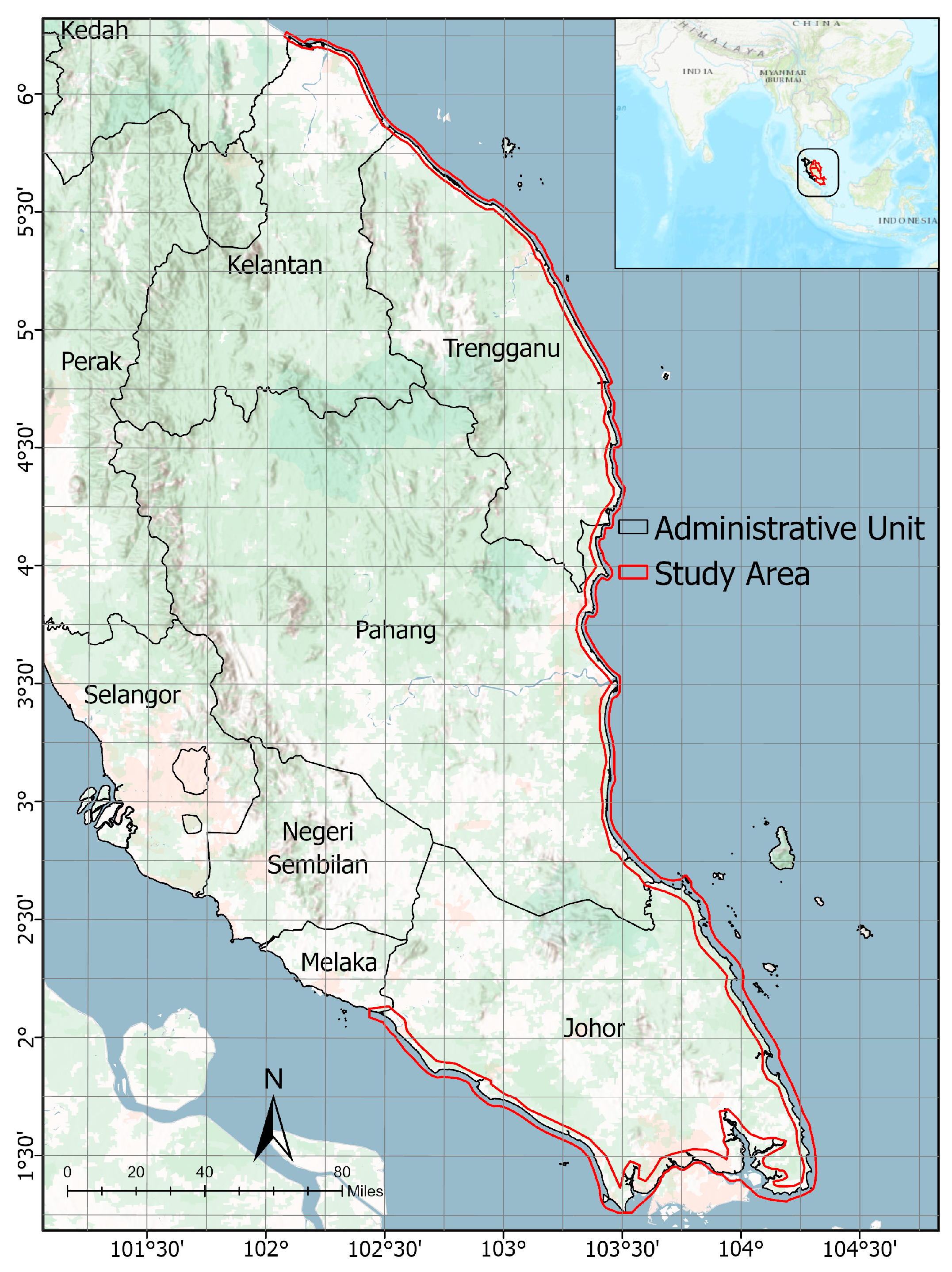
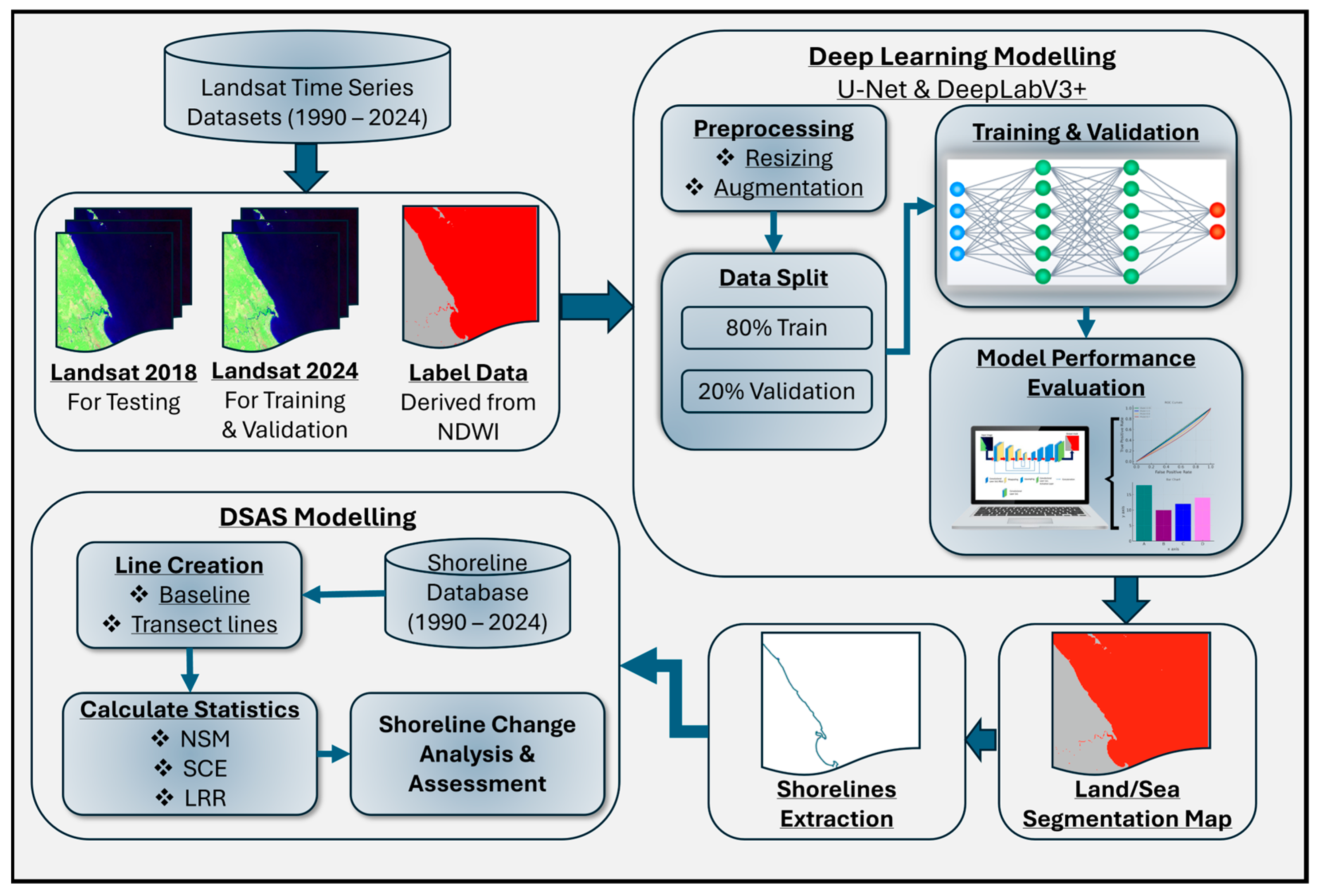
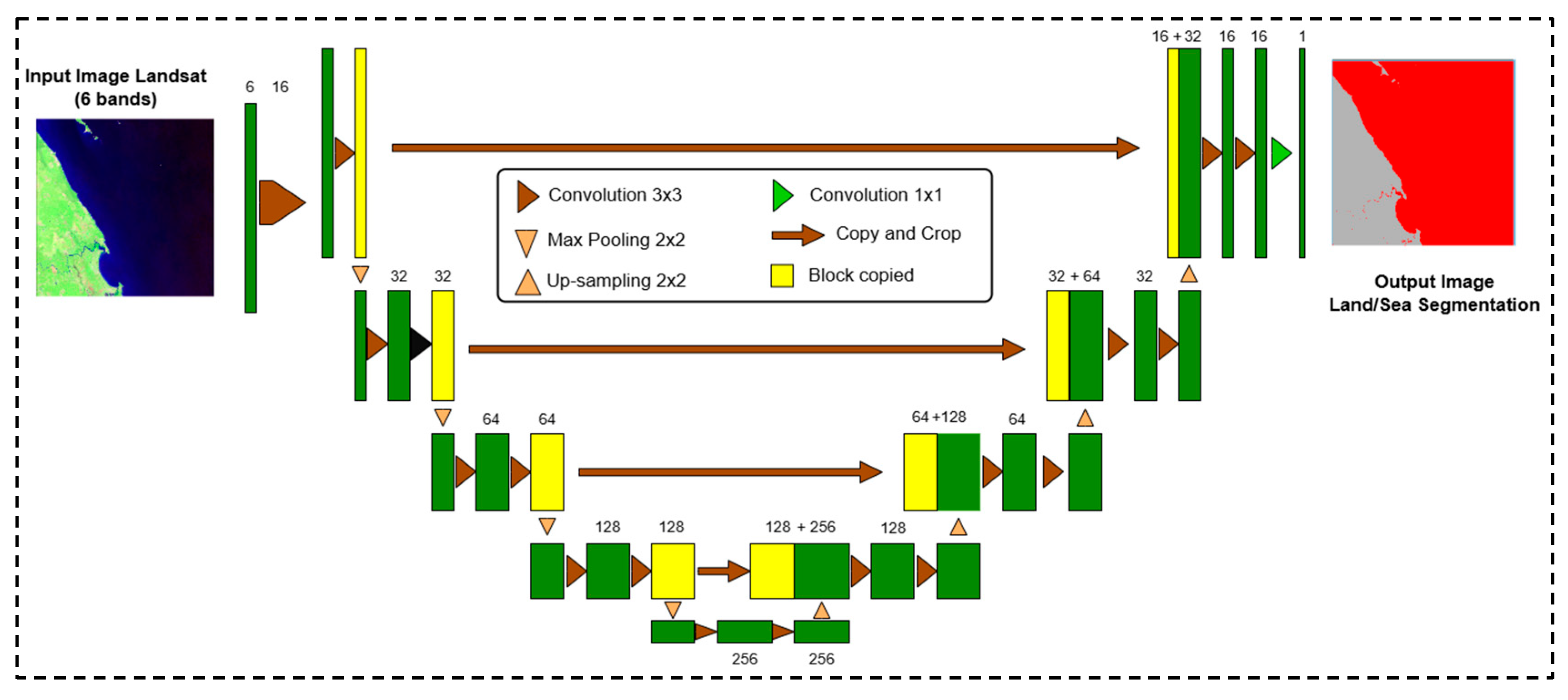
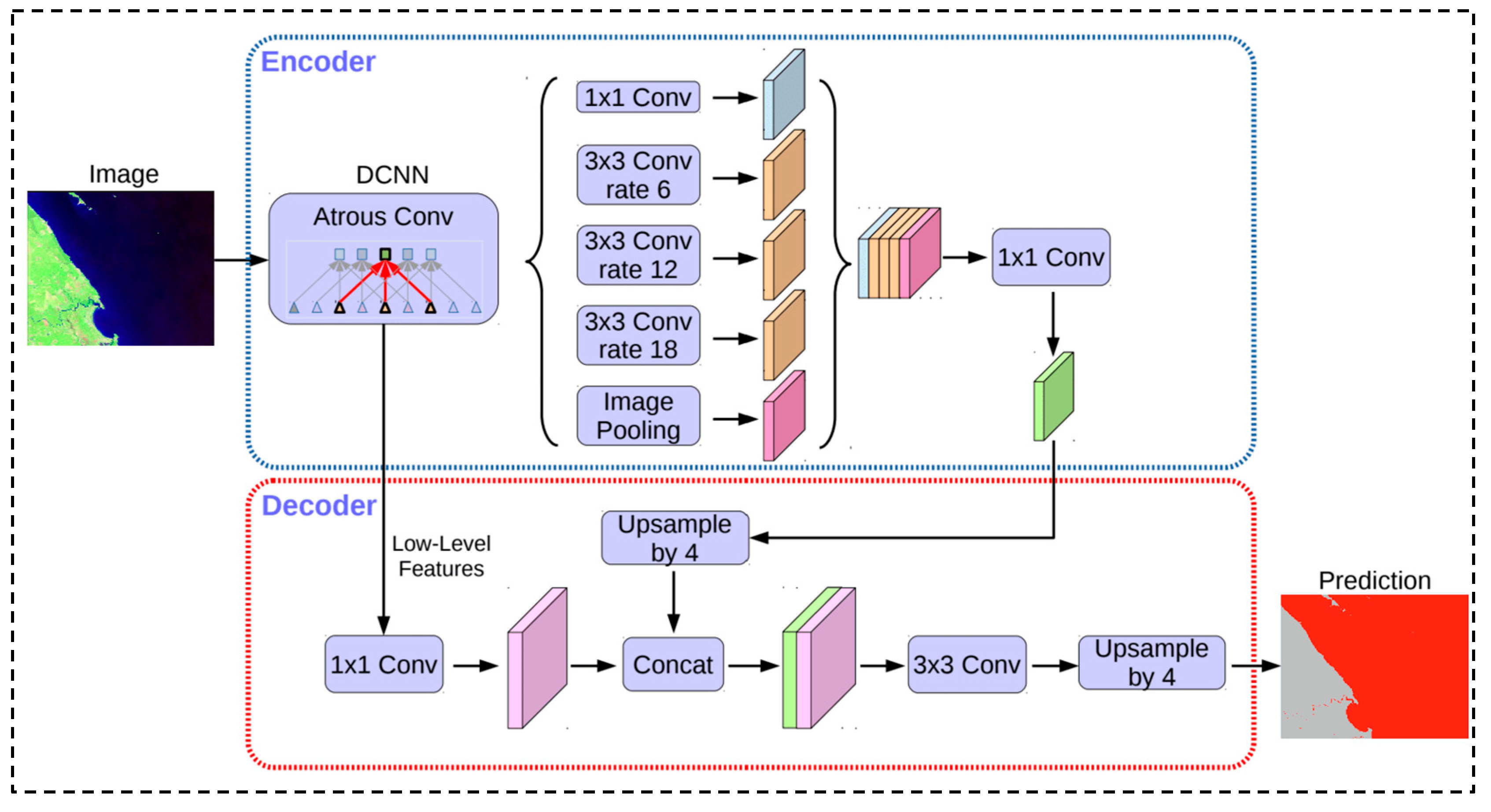
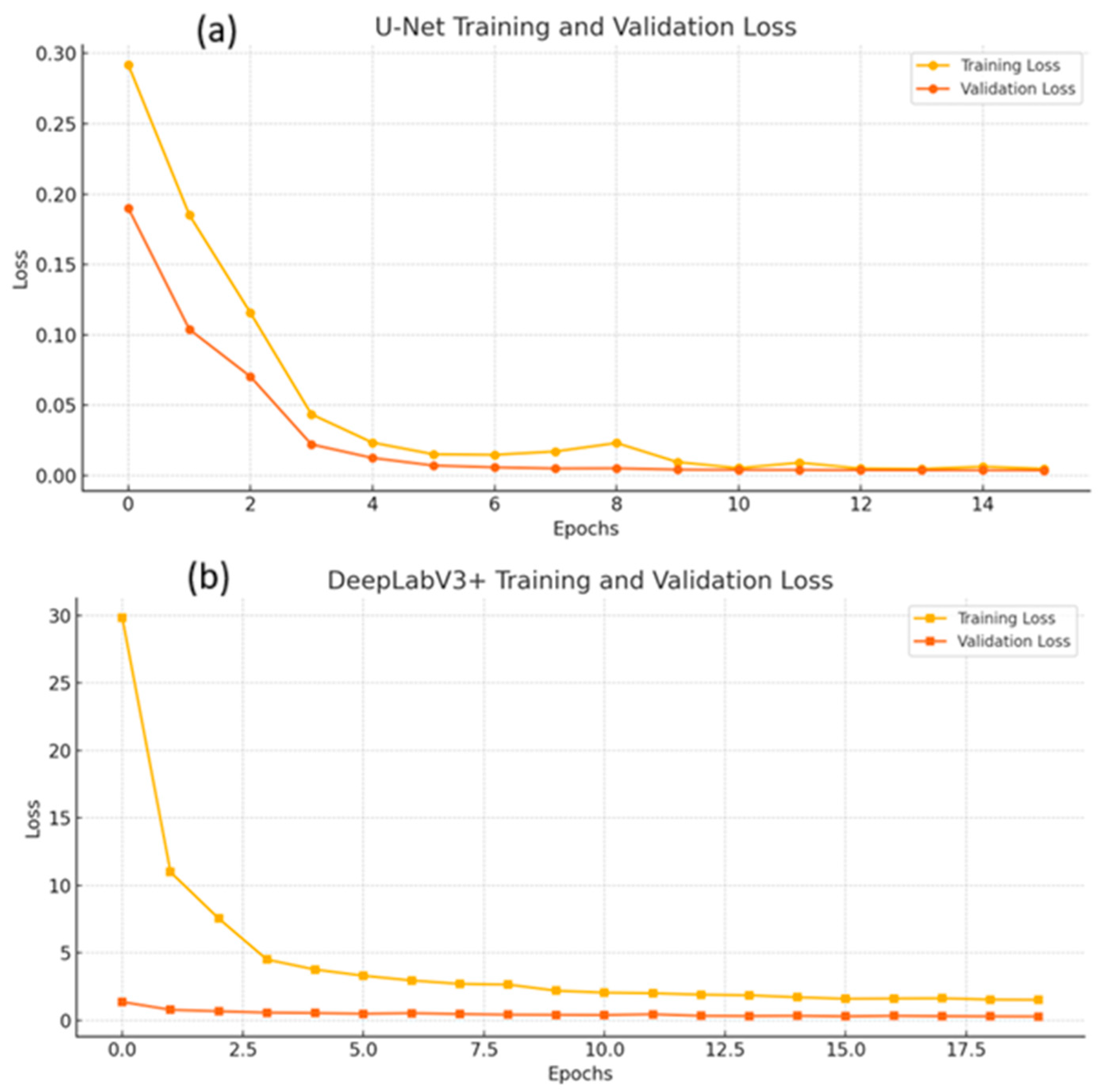
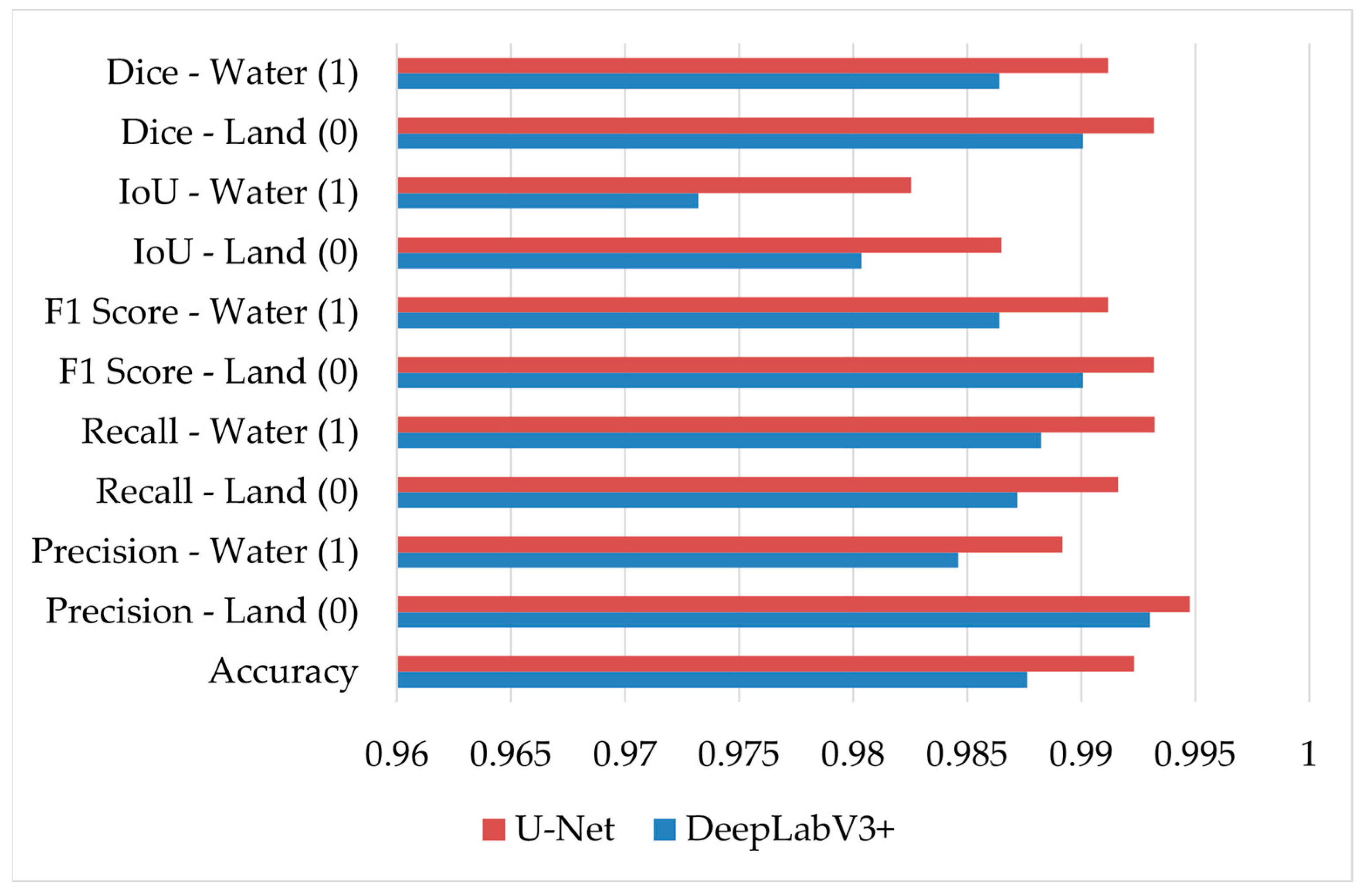
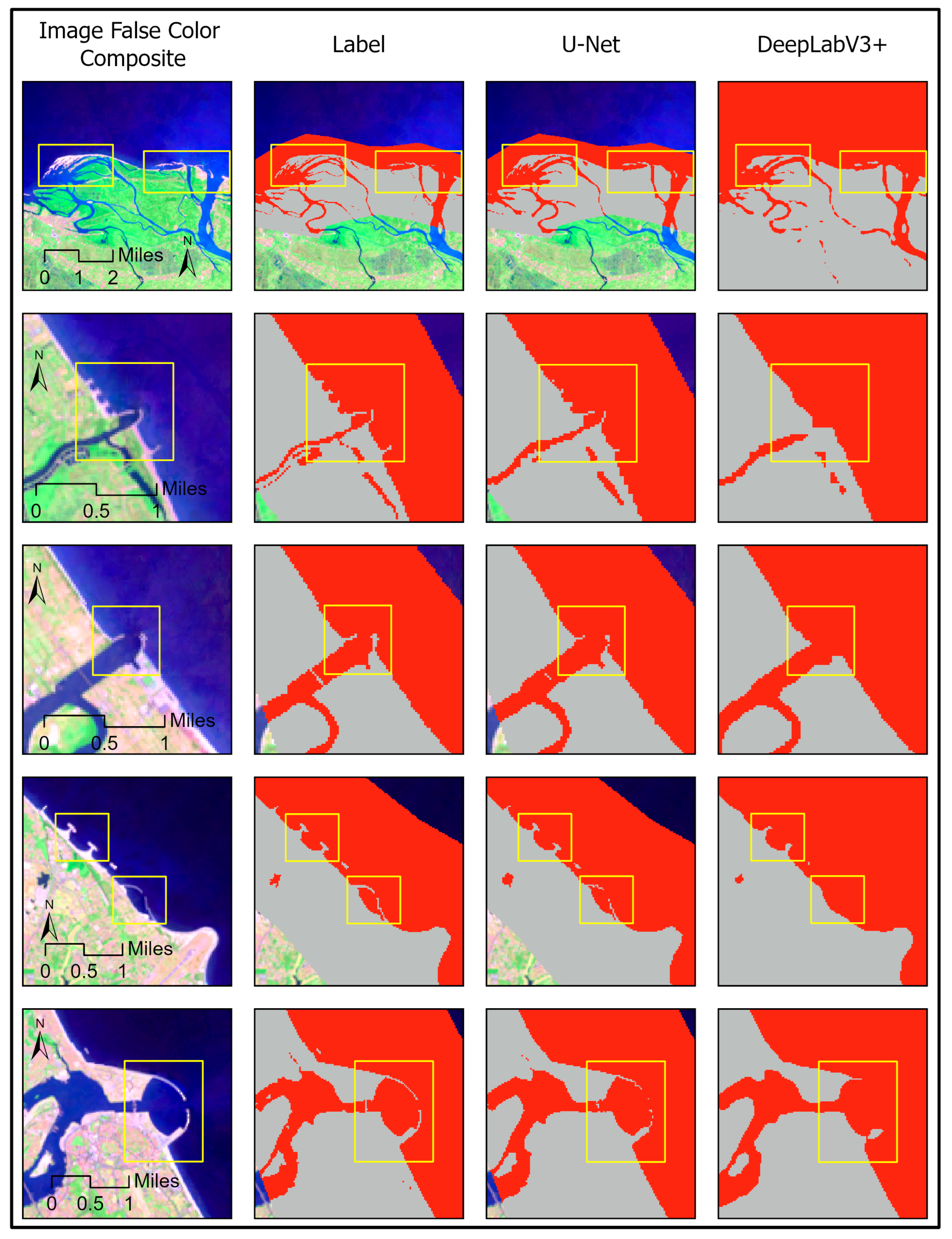
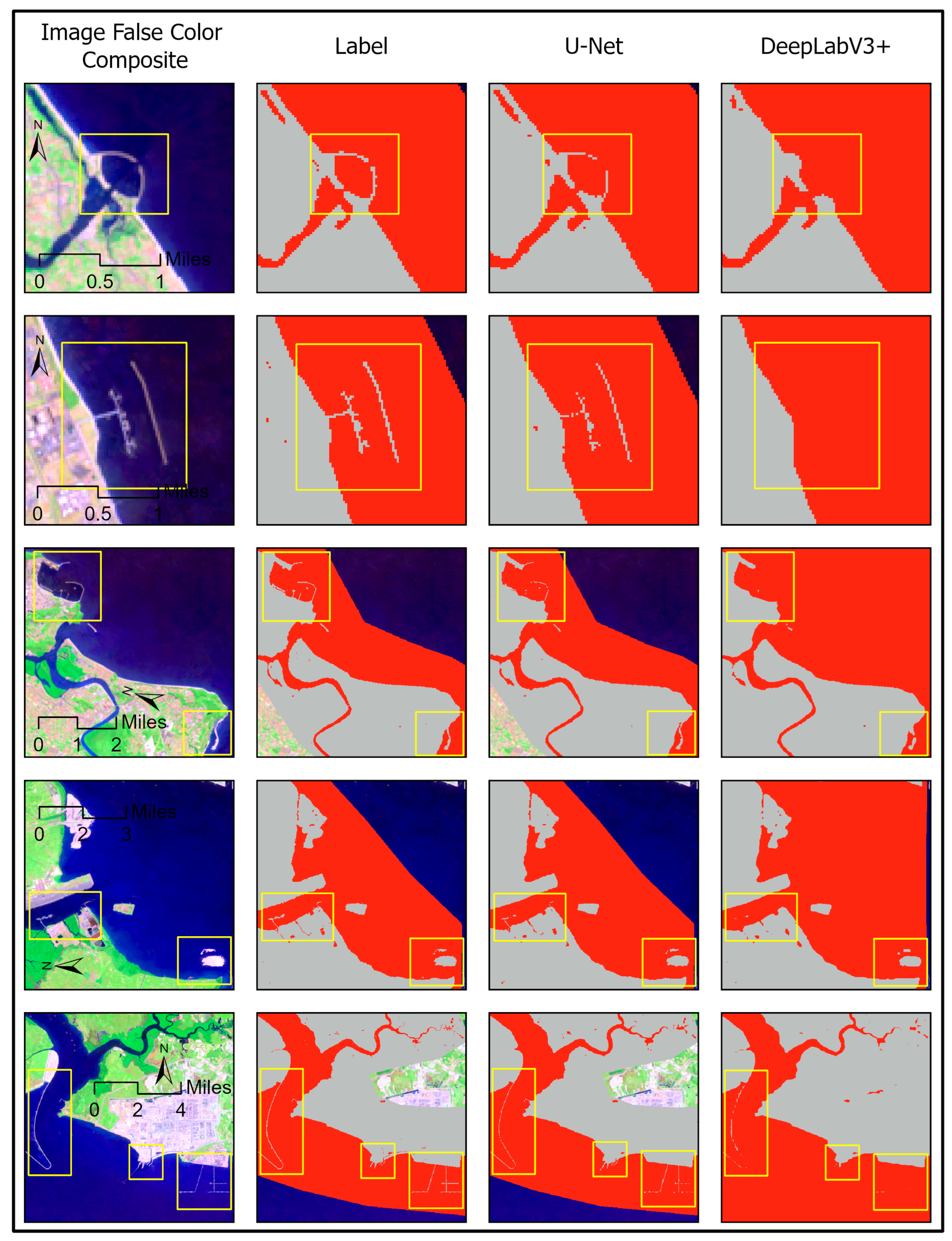
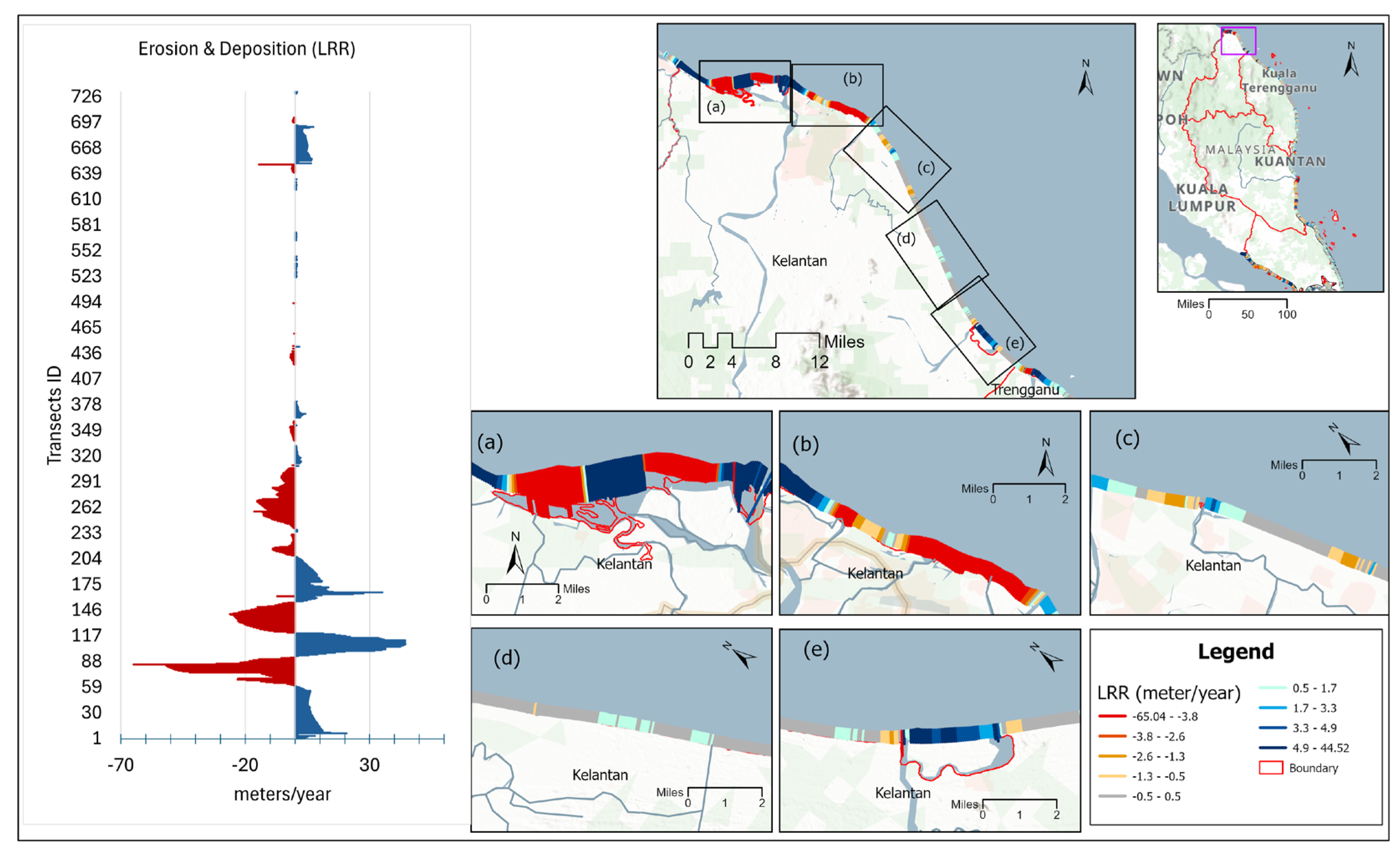
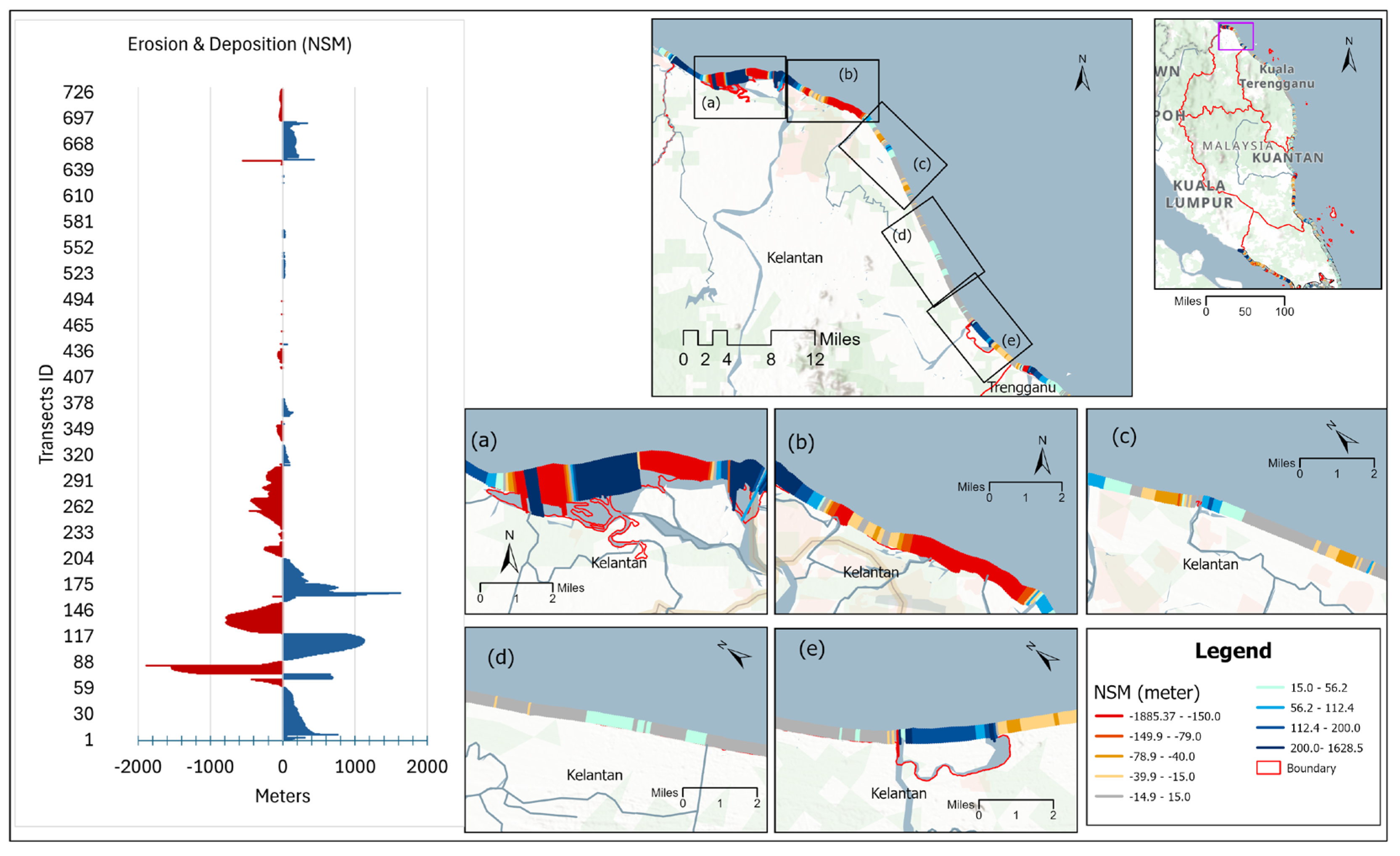
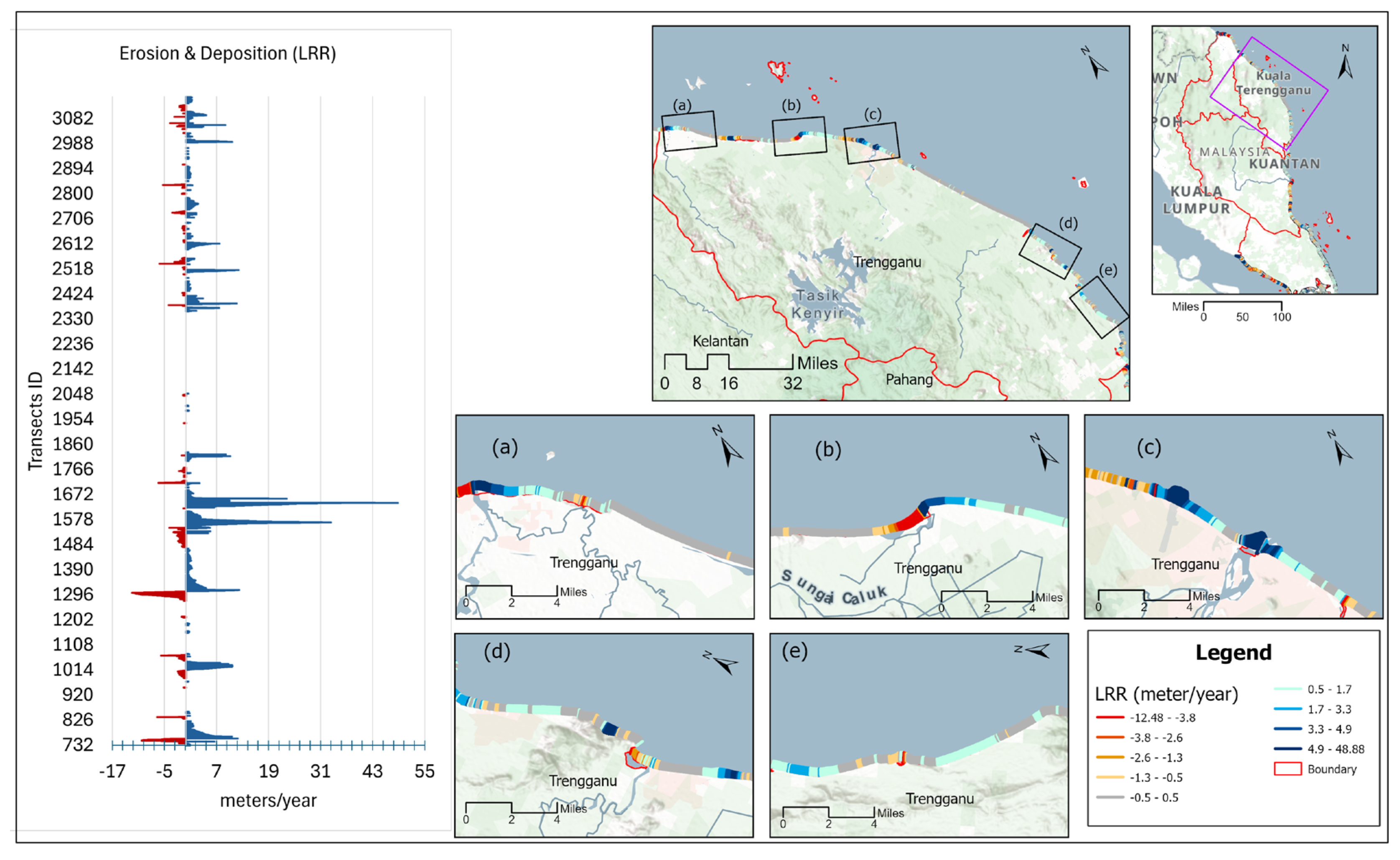
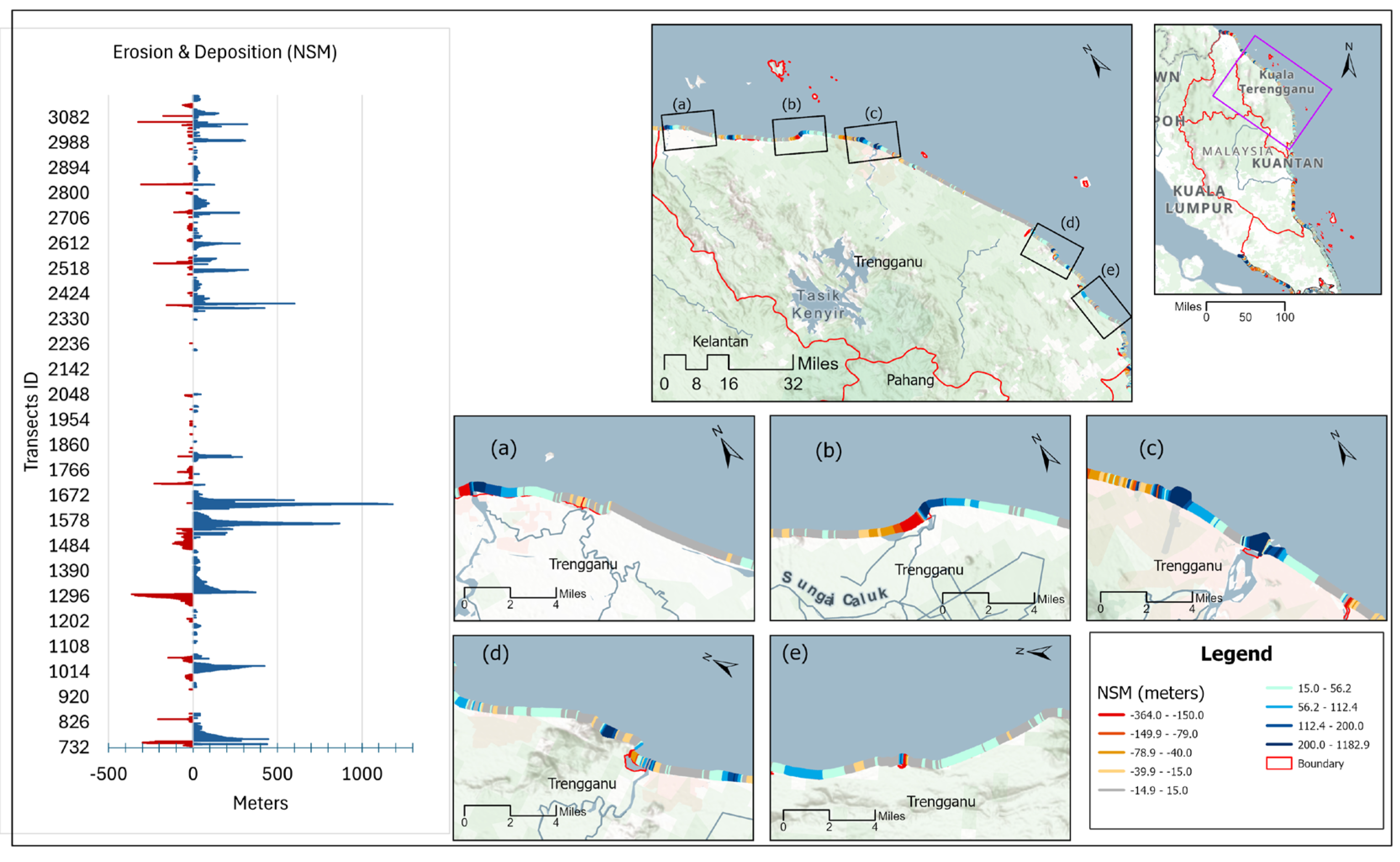
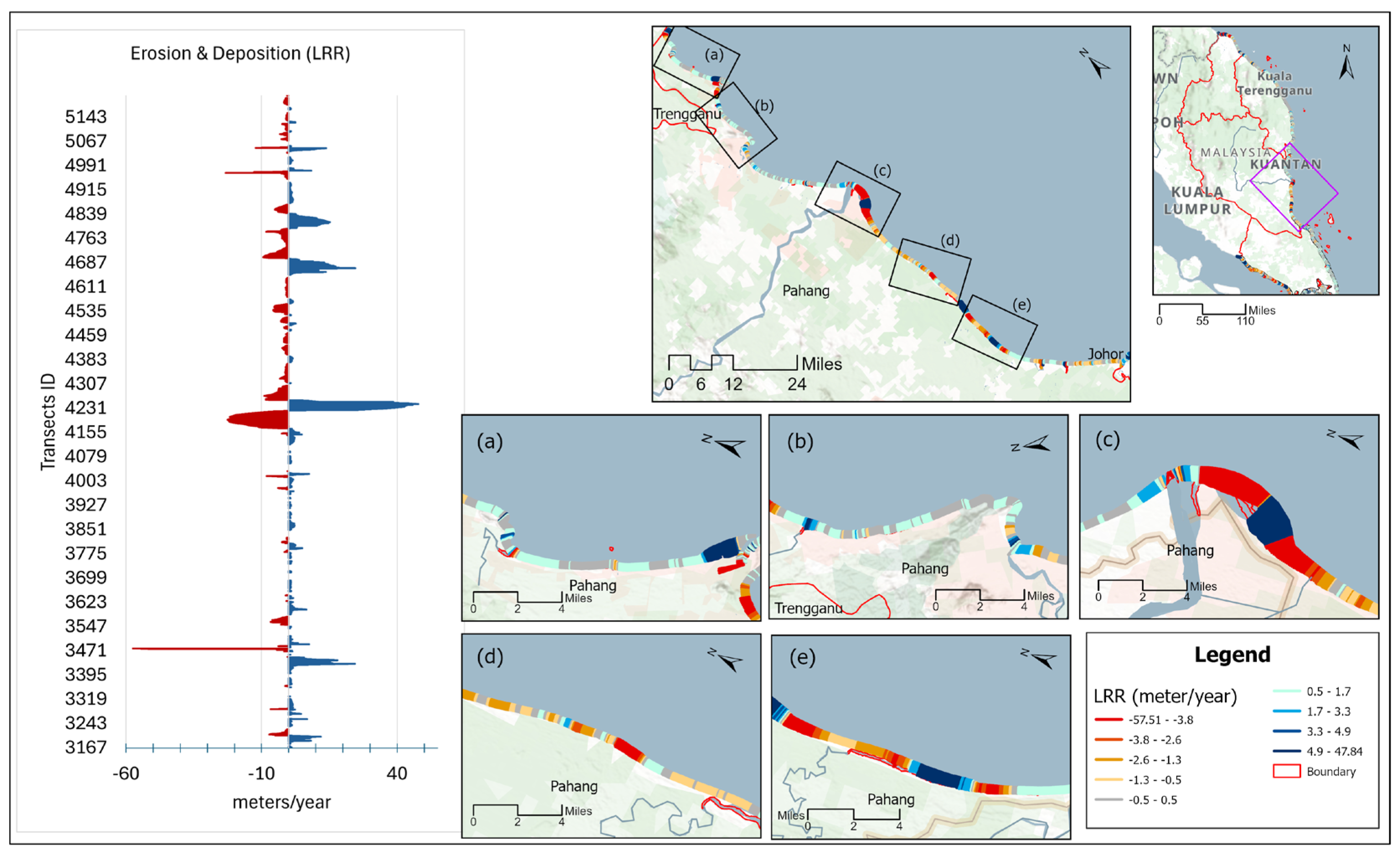

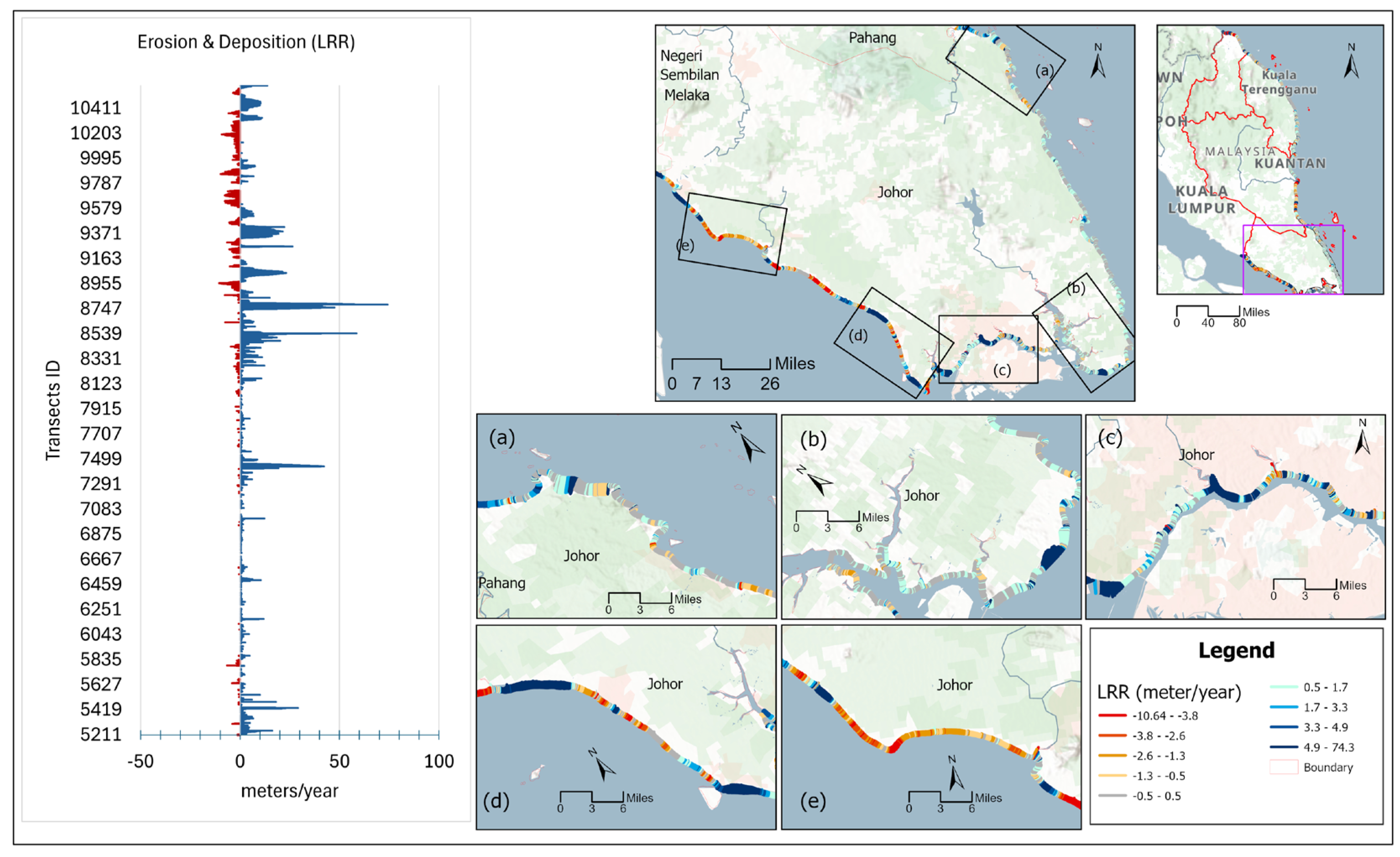
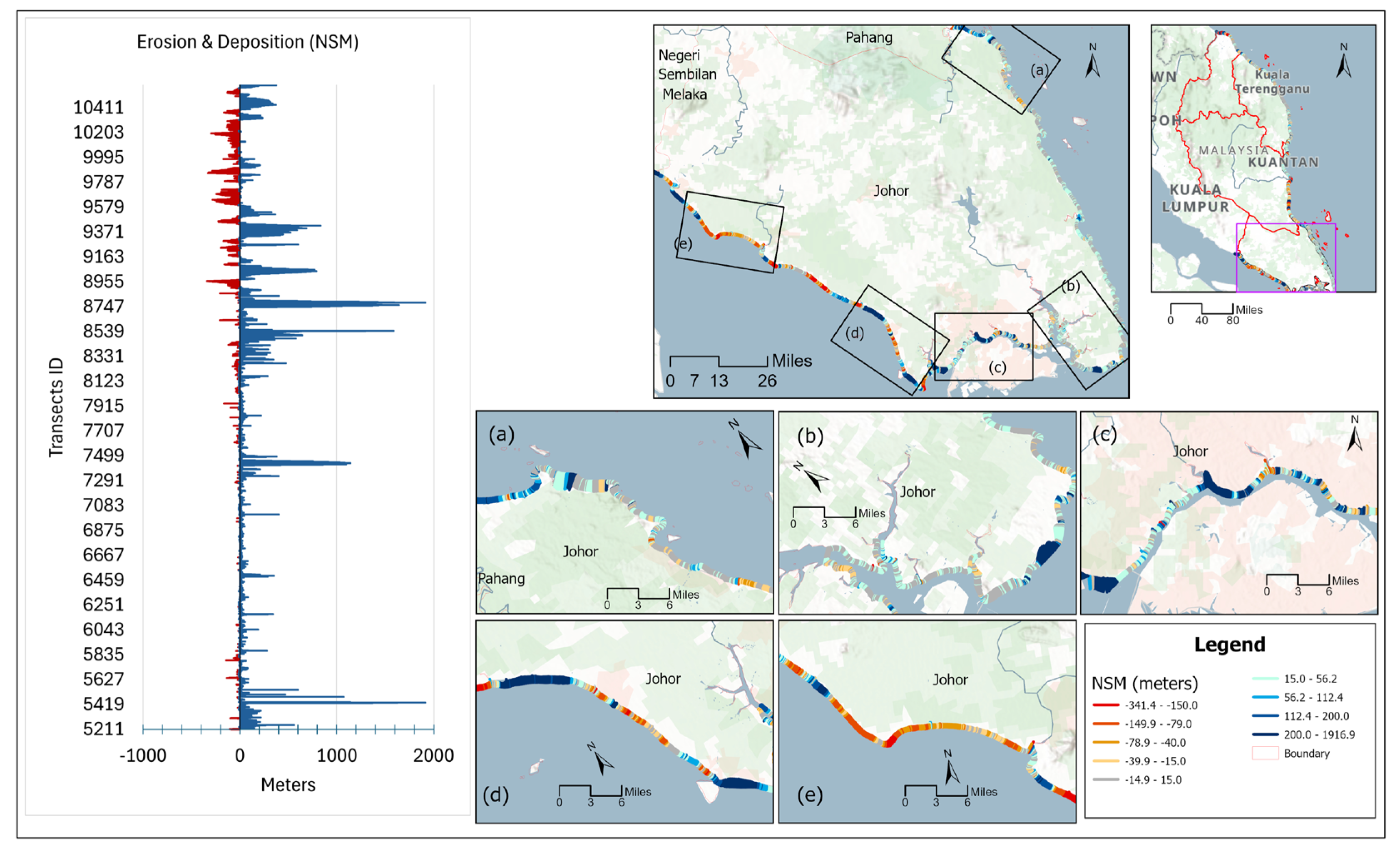
| Year | Sensor | Product Level | Bands Used | Source/Platform | Handling Approach | Application |
|---|---|---|---|---|---|---|
| 1990, 1993, 1998 | Landsat 5 TM | Level 2 | Blue–SWIR | Google Earth Engine | Annual composite, cloud-free | Shoreline extraction |
| 2002, 2008 | Landsat 7 ETM+ | Level 2 | Blue–SWIR | Google Earth Engine | Annual composite, cloud-free | Shoreline extraction |
| 2014 | Landsat 8 OLI | Level 2 | Blue–SWIR | Google Earth Engine | Annual composite, cloud-free | Shoreline extraction |
| 2018 | Landsat 8 OLI | Level 2 | Blue–SWIR | Google Earth Engine | Annual composite, cloud-free | Model testing |
| 2024 | Landsat 9 OLI | Level 2 | Blue–SWIR | Google Earth Engine | Annual composite, cloud-free | Model training/development |
| Augmentation | Parameter Range | Description |
|---|---|---|
| Random Rotation | ±15° | Simulates small orientation changes without distorting shoreline geometry |
| Horizontal Flip | p = 0.5 | Handles coastline direction variability; common in segmentation tasks |
| Vertical Flip | p = 0.5 | Adds invariance to shoreline orientation and acquisition geometry |
| Brightness Adjustment | Factor 0.8–1.2 | Accounts for seasonal illumination and atmospheric variability in Landsat composites |
| Component | Setting | Justification |
|---|---|---|
| Input Tile Size | 512 × 512 pixels | Balances computational efficiency with sufficient contextual information [27,33] |
| Loss Function | Binary Cross-Entropy | Stable for balanced binary segmentation |
| Batch Size | 8 | Fits GPU memory while maintaining gradient stability. |
| Epochs | 20 | Sufficient for convergence under augmentation |
| Optimizer | Adam | Adaptive learning rate; widely adopted for segmentation tasks |
| Initial Learning Rate | 1 × 10−4 | Common default for Adam in semantic segmentation; stable convergence. |
| LR Schedule | ReduceLROnPlateau (factor = 0.5; patience = 3; min LR = 1 × 10−5) | Prevents stagnation; accelerates convergence when validation loss plateaus. |
| Early Stopping | Patience = 5 (monitor validation loss) | Stops training when no improvement; reduces overfitting risk |
| Checkpointing | Save best weights | Ensures reproducibility and best generalization |
| Validation Split | 20% of training dataset | Standard practice for moderate datasets to monitor generalization. |
| Year | Georeferencing Error (Eg) (m) | Pixel Error (Ep) (m) | Tidal Error (Etide) (m) | Total Uncertainty (U) (m) |
|---|---|---|---|---|
| 1990 | 50 | 15 | 100 | 112.81 |
| 1993 | 50 | 15 | 100 | 112.81 |
| 1998 | 50 | 15 | 100 | 112.81 |
| 2002 | 50 | 15 | 100 | 112.81 |
| 2008 | 50 | 15 | 100 | 112.81 |
| 2014 | 12 | 15 | 100 | 101.83 |
| 2018 | 12 | 15 | 100 | 101.83 |
| 2024 | 12 | 15 | 100 | 101.83 |
| Model | Class | Precision | Recall | F1 Score |
|---|---|---|---|---|
| U-Net | Land | 0.9983 | 0.9977 | 0.9979 |
| Water | 0.9987 | 0.9991 | 0.9989 | |
| DeepLabV3+ | Land | 0.9973 | 0.9972 | 0.9973 |
| Water | 0.9988 | 0.9988 | 0.9988 |
| Descriptive Statistics | Kelantan | Terengganu | Pahang | Johor | Total |
|---|---|---|---|---|---|
| Transect ID range | 1–731 | 732–3166 | 3167–5210 | 5211–10,601 | 1–10,601 |
| Total no. of Transects | 731 | 2435 | 2044 | 5391 | 10,601 |
| Mean Shoreline Change Envelope (SCE) | 256.4 | 60.1 | 143.3 | 103.4 | 111.7 |
| Maximum Shoreline Change Envelope (SCE) | 2034.2 | 1197.2 | 2061 | 1926 | 2061 |
| Minimum Shoreline Change Envelope (SCE) | 0 | 0.45 | 0 | 0.9 | 0 |
| Percentage of Transects exhibiting erosion (LRR) | 30.1 | 13 | 33 | 20.5 | 21.8 |
| Percentage of Transects exhibiting accretion (LRR) | 36.94 | 32 | 38 | 41 | 38.1 |
| Percentage of stable transects (LRR) | 32.96 | 55 | 29 | 38.5 | 40.1 |
| Maximum Erosion (NSM based) (m) | −1885.4 | −364 | −1658.2 | −341.4 | −1885.4 |
| Mean Erosion (NSM based) (m) | −78 | −8.3 | −41.1 | −17 | −23.9 |
| Maximum Accretion (NSM based) (m) | 1628.5 | 1183 | 2028.1 | 1917 | 2028.1 |
| Mean Accretion (NSM based) (m) | 95 | 31 | 62.8 | 66.4 | 59 |
| Percentage of Transects exhibiting erosion (NSM) | 32.1 | 14.1 | 34 | 20.7 | 22.5 |
| Percentage of Transects exhibiting accretion (NSM) | 36.7 | 33.8 | 44 | 44 | 41.1 |
| Percentage of stable transects (NSM) | 31.2 | 52.1 | 22 | 35.3 | 36.4 |
| Mean Erosion rate (m/year) | −2.9 | −0.25 | −1.24 | −0.52 | −0.76 |
| Mean Accretion rate (m/year) | 2.63 | 0.98 | 1.6 | 1.92 | 1.7 |
Disclaimer/Publisher’s Note: The statements, opinions and data contained in all publications are solely those of the individual author(s) and contributor(s) and not of MDPI and/or the editor(s). MDPI and/or the editor(s) disclaim responsibility for any injury to people or property resulting from any ideas, methods, instructions or products referred to in the content. |
© 2025 by the authors. Licensee MDPI, Basel, Switzerland. This article is an open access article distributed under the terms and conditions of the Creative Commons Attribution (CC BY) license (https://creativecommons.org/licenses/by/4.0/).
Share and Cite
Khurram, S.; Pour, A.B.; Bagheri, M.; Helmy Ariffin, E.; Akhir, M.F.; Bahri Hamzah, S. Satellite-Based Multi-Decadal Shoreline Change Detection by Integrating Deep Learning with DSAS: Eastern and Southern Coastal Regions of Peninsular Malaysia. Remote Sens. 2025, 17, 3334. https://doi.org/10.3390/rs17193334
Khurram S, Pour AB, Bagheri M, Helmy Ariffin E, Akhir MF, Bahri Hamzah S. Satellite-Based Multi-Decadal Shoreline Change Detection by Integrating Deep Learning with DSAS: Eastern and Southern Coastal Regions of Peninsular Malaysia. Remote Sensing. 2025; 17(19):3334. https://doi.org/10.3390/rs17193334
Chicago/Turabian StyleKhurram, Saima, Amin Beiranvand Pour, Milad Bagheri, Effi Helmy Ariffin, Mohd Fadzil Akhir, and Saiful Bahri Hamzah. 2025. "Satellite-Based Multi-Decadal Shoreline Change Detection by Integrating Deep Learning with DSAS: Eastern and Southern Coastal Regions of Peninsular Malaysia" Remote Sensing 17, no. 19: 3334. https://doi.org/10.3390/rs17193334
APA StyleKhurram, S., Pour, A. B., Bagheri, M., Helmy Ariffin, E., Akhir, M. F., & Bahri Hamzah, S. (2025). Satellite-Based Multi-Decadal Shoreline Change Detection by Integrating Deep Learning with DSAS: Eastern and Southern Coastal Regions of Peninsular Malaysia. Remote Sensing, 17(19), 3334. https://doi.org/10.3390/rs17193334








